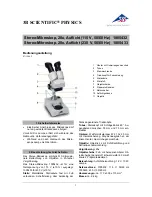
16
Experiment No. 3: Textile fi bers
Objects and accessories:
1. threads from various fabrics (e.g.
cotton, linen, sheep’s wool, silk,
rayon, etc.),
2. two needles.
Place the different threads on a table
and use the needles to fray them a
bit. Dampen the threads with a little
water. Set your microscope to the
lowest magnifi cation and place it on
the threads, one at a time.
Compare: Cotton fi bers come from
a plant, and look like a fl at, twisted
ribbon under the microscope. The
fi bers are thicker and rounder at the
edges than in the middle. Cotton
fi bers are basically long, collapsed
tubes. Linen fi bers also come from
a plant, and they are round and run
in one direction. The fi bers shine like
silk and exhibit countless bulges on
the thread. Silk comes from an ani-
mal and is made up of solid fi bers that
are small in diameter, in contrast to
the hollow plant-based fi bers. Each
fi ber is smooth and even and looks
like a tiny glass tube. The fi bers of
the sheep’s wool also come from an
animal. The surface is made of over-
lapping sleeves that look broken and
wavy. If possible, compare sheep’s
wool from different weaving mills. In
doing so, take a look at the different
appearance of the fi bers. Experts
can determine which country the
wool came from by doing this. Rayon
is a synthetic material that is pro-
duced by a long chemical process.
All the fi bers have solid, dark lines on
the smooth, shiny surface. After dry-
ing, the fi bers curl into the same posi-
tion. Observe the differences and the
similarities.
Experiment No. 4: Table Salt
Object: normal table salt.
Place a sheet of black paper on a
desk. Sprinkle a few grains of salt on
the paper and place the microscope
on top of them. Look at the salt crys-
tals using the lowest magnifi cation of
your microscope.
Observe: The crystals look like tiny
dice and all have the same shape.
Experiment No. 5:
Leaves and Needles
Object: 3-4 different leaves or nee-
dles from deciduous trees or fi
r
trees.
When you go for a walk in the forest
with your parents, you can collect dif-
ferent types of leaves and needles.
At home, place them next to each
other on a white sheet of paper. Place
your microscope on top of them and
look at the different leaves and nee-
dles with the lowest magnifi cation.
Observe: The leaves of the decidu-
ous trees have different but more or
less regular sections that are separat-
ed by lines. These are called “cells.”
Most often, the underside of the leaf
looks different than the top, and the
















































